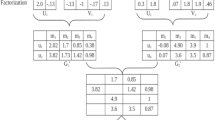Abstract
A new 2-D FFT algorithm is described. This algorithm applies a 2-D matrix factorization technique in a 2-D space and offers a way to do 2-D FFT in both dimensions simultaneously. The computation is greatly reduced compared to traditional algorithms. This will improve the realization of a 2-D FFT on any kind of computer. However its good parallelism will especially benefit an implementation on a computer with hypercube architecture. A good arrangement of parallel processors will save a great deal of running time. Furthermore this algorithm can be extended toM-D cases forM>2.
Similar content being viewed by others
Explore related subjects
Discover the latest articles, news and stories from top researchers in related subjects.References
F. Theilheimer, “A Matrix Version of the Fast Fourier Transform,”IEEE Trans., vol. AU-17, no. 2, 1969, pp. 158–161.
D.K. Kahaner, “Matrix Description of the Fast Fourier Transform,”IEEE, vol. AU-18, no. 4, December 1970, pp. 442–450.
E.O. Brigham, “The Fast Fourier Transform,” Englewood Cliffs, NJ: Prentice-Hall, 1974.
H.C. Andrews, and W.K. Pratt, “Digital Computer Simulation of Coherent Optical Processing Operations,”Computer Group News, November 1968, pp. 12–19.
M. Jagadeesan, “N-Dimensional Fast Fourier Transform,”13th Midwest Symp. Circuit Theory, Minneapolis, MN, May, 1970, pp. 3.2.1–3.2.8.
H.J. Nussbaumer, “New Algorithms for Convolution and DFT Based on Polynomial Transforms,”1978 Proc. IEEE Int. Conf. ASSP, 1978, pp. 638–641.
H.J. Nussbaumer, and P. Quandalle, “Fast Computation of Discrete Fourier Transforms Using Polynomial Transforms,”IEEE, vol. ASSP-27, no. 2, 1979, pp. 169–181.
D.B. Harris, J.H. McClellan, D.S.K. Chan, and H.W. Schuessler, “Vector Radix Fast Fourier Transform,”1977 IEEE Int. Conf. ASSP Record, pp. 548–551.
A. Guessoum, and R.M. Merserean, “Fast Algorithms for the Multidimensional Discrete Fourier Transform,”IEEE, vol. ASSP-34, no. 4, August 1986, pp. 937–943.
W.M. Gentleman, and G. Sande, “The Fast Fourier Transform for Fun and Profit,”AFIPS Proc., 1966 Fall Joint Computer Conf. vol. 29, Washington, D.C., pp. 563–678.
A. Granham, “Kronecker Products and Matrix Calculus with Applications,” New York: Ellis Horwood 1981.
Author information
Authors and Affiliations
Additional information
Supported by NSF Grant CCR-8813493.
Supported by Grants DMS-8607687, DMS-8722402, and DMS9002019.
Rights and permissions
About this article
Cite this article
Wang, M., Lee, E.B. 2-D FFT algorithm by matrix factorization in a 2-D space. Multidim Syst Sign Process 5, 61–74 (1994). https://doi.org/10.1007/BF00985863
Received:
Revised:
Issue Date:
DOI: https://doi.org/10.1007/BF00985863




